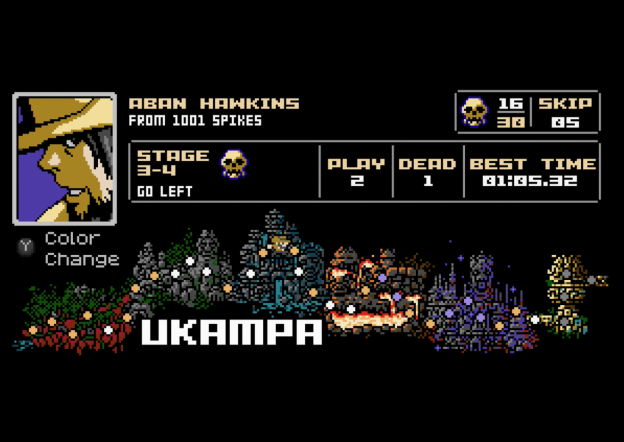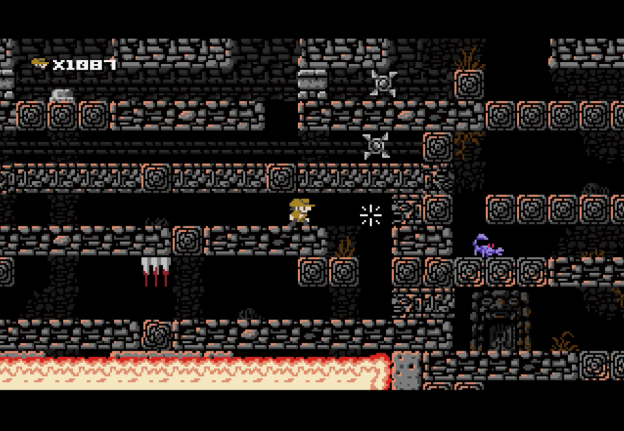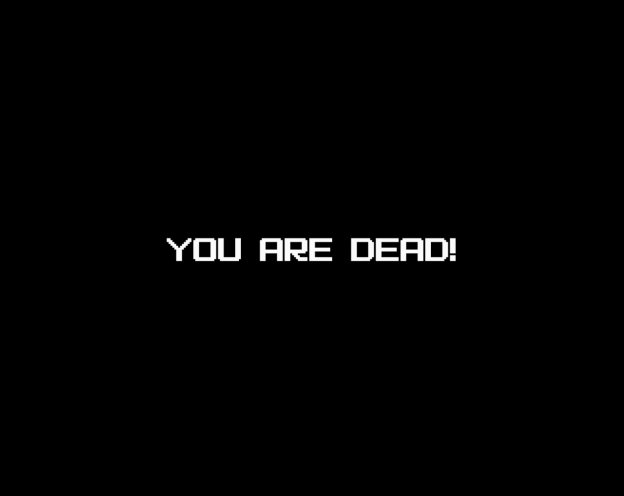I’m going to get this out straight away: 1001 Spikes is a game for those looking for an incredibly difficult challenge. If you do not think you are into this sort of gameplay, chances are this game is not for you.
The objective of 1001 Spikes is clear from the get-go; Aban Hawkins looks to make a fortune by navigating through the countless deadly traps in the Ukampa Ruins of South America. The game’s 8-bit aesthetics go more than skin-deep; the visuals, the sounds, and the difficulty all harken back to the classic NES days. Developer Nicalis set out to make the toughest game they could. Each level is littered with traps and enemies, and Hawkins can’t take any hits, or else the player will be greeted by a soon-to-be familiar screen “YOU ARE DEAD!”
Since the game revolves around precise platforming, the controls are expectedly responsive. Interestingly, the game has two jump buttons: “B” to jump one block high, and “Y” to jump two blocks high. Most every level will make use of both jumps, which helps keep the gameplay fresh and the player thinking. Hawkins has throwing knives, and can only throw three at a time Mega Man style. While there are some enemies littering the levels, the knives will be mostly used for hitting switches and countering blow-gun darts.
The first few levels lure are more-or-less for tutorial purposes. Difficulty here is minimal, allowing player to grasp the game’s controls and can get an idea of what the game will throw at them. However, after the first two worlds, difficulty will skyrocket, and will remain high for the remainder of the campaign. A golden token is hidden in each level, and upon grabbing it, restores one life. Every time you replay the level, the token reappears, allowing you the chance to grab another extra life. On many boards, these tokens serve to keep you from worrying about your life count.
As difficult as the game becomes, poor game mechanics or level design are never to blame for character death. Each level has it’s own rhythm, and it will be up to the player to learn it in order go make it through. Even with the game’s simple concepts, Nicalis is able to squeeze out a surprisingly large variety of levels out of 1001 Spikes. Levels rarely repeat themselves, and many have elements, such as fireballs or horizontally-stomping totems, that only exist in a couple of areas. The game never deviates from the core mechanics of the game, making the variety all the more impressive. Checkpoints in levels are non-existent, but as these levels only last a few minutes each, this is nothing to fret over.
What I will fret over, however, is a certain screen everyone playing the game will become very familiar with: the “YOU ARE DEAD!” screen. In a game where the player will be almost expected to die, the death screen can be tremendously grating. I suspect the screen serves as a means to reset the level, but that doesn’t stop it from wearing down my patience over time.
Every so often the game gives the player a break with an easier level. The end of each world ends with a quick jaunt through a section of ruins ending with a key that restores a massive amount of lives. Don’t think you can revisit the level to gain more, though. Getting a key you’ve already received results in an automatic loss of ten lives. Remember, this game is not for the weak of heart.
Reflexes alone will not get players through this game. Much of 1001 Spikes’ gameplay demands trial and error, with players memorizing the level right down to how many seconds they should remain at a certain spot. Sudden spike traps, or the blow-gun walls will take a generous chunk out of your large bank of lives. Clicking sounds will alert players to traps, but often times, the music or other noises will obscure it, and the player will be greeted by yet another “YOU ARE DEAD!” screen. Traps set at the levels exit are the most frustrating; your sigh of relief and sense of fulfillment are immediately taken away as a stray trap take out Hawkins, and you once again are greeted by those infamous words “YOU ARE DEAD!”
If you are in need of extra lives, you can acquire coins through unlock-able min-games, and spend them at shops. While there are three games, only two of them have any real meat. One game consists of players attempting to scale a tower in order to save the daughter of a villager. The screen scrolls upward as players avoid obstacles and collect treasure chests. The games are built for multiplayer in mind, so the challenge is not not nearly as high as the main campaign. Players can choose from a variety of six characters, each with their own unique play-style; some characters have slower-moving jumps, others can jump-dash, and one in particular has no projectile attacks.
These characters can also be unlocked in the main campaign, which bolsters replay-ability, but not by much. Like the multiplayer, these characters bring their own mechanics to the game, and some even have their own intros. Each character has to move through the campaign separately, but they all share a single pool of lives with Hawkins, so make sure you are confident in you platforming before you start into these runs.
1001 Spikes is an incredibly tough, and often times frustrating, experience. However, 1001 Spikes is by no means a terrible game. The gameplay is simple, but Nicalis is able to extract a lot of depth and variability in just these few mechanics. Though its main selling point, 1001 Spikes’ incredible difficulty may keep a lot of people from picking it up, which is a shame, because 1001 Spikes is a solid title to add to any platforming enthusiast’s collection.
PN Review: 1001 Spikes (Wii U)
Perfect for those looking for a challenge







June 25, 2014
I’m glad you were able to review this Matt – nice job! :)